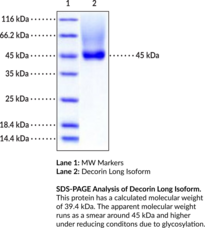Territorial Availability: Available through Bertin Technologies only in France
- Correlated keywords
- HEK 293 extra cellular PGS2 PG40 PGII CSCD DSPG2 SLRR1B MTLn 3 Gly 17
- Product Overview:
Decorin is an extracellular matrix protein and member of the leucine-rich proteoglycan family that influences many cellular functions, including adhesion, growth, differentiation, proliferation, and survival.{54217,54218} Alternative splicing of DCN pre-mRNA generates five isoforms of varying length.{54219} Decorin contains a core protein that mediates ligand binding and is composed of a cysteine-rich domain covalently linked to a chondroitin or dermatan sulfate glycosaminoglycan chain and a leucine-rich repeat (LRR) domain that can bind up to three N-linked oligosacchaides.{54220,54221} The core protein is flanked by an N-terminal signal peptide and propeptide domain, which regulate decorin secretion, and a C-terminal domain that is truncated in mutant forms of DCN. Decorin is secreted as a monomer and expressed by endothelial cells and cancer cells in a variety of tissues.{54217} It is induced by autophagic stimuli, including mTOR inhibition and nutrient deprivation, and downregulated by the adhesion protein periostin.{54222,54223} Decorin binds to and sequesters a variety of molecules, including extracellular matrix proteins, growth factors and their receptors, cytokines, enzymes, hormones, and lipoproteins.{54220} It also enhances integrin-collagen interactions, promoting angiogenesis.{54224} Intravenous administration of the decorin core protein reduces tumor growth and lung metastases in an MTLn3 mouse xenograft model.{54225} Decreased decorin tumor levels are associated with low disease-free and overall survival rates in patients with spindle cell sarcomas.{54224} Frameshift mutations in DCN have been associated with congenital stromal corneal dystrophy, a condition characterized by corneal opacity.{54221} Cayman’s Decorin Long Isoform (human, recombinant) protein consists of 354 amino acids, has a calculated molecular weight of 39.4 kDa, and a predicted N-terminus of Gly17 after signal peptide cleavage. Differential glycosylation of decorin results in the presence of multiple protein bands causing the observed smear at approximately 45 kDa and higher when observed by SDS-PAGE under reducing conditions.
Cayman Chemical’s mission is to help make research possible by supplying scientists worldwide with the basic research tools necessary for advancing human and animal health. Our utmost commitment to healthcare researchers is to offer the highest quality products with an affordable pricing policy.
Our scientists are experts in the synthesis, purification, and characterization of biochemicals ranging from small drug-like heterocycles to complex biolipids, fatty acids, and many others. We are also highly skilled in all aspects of assay and antibody development, protein expression, crystallization, and structure determination.
Over the past thirty years, Cayman developed a deep knowledge base in lipid biochemistry, including research involving the arachidonic acid cascade, inositol phosphates, and cannabinoids. This knowledge enabled the production of reagents of exceptional quality for cancer, oxidative injury, epigenetics, neuroscience, inflammation, metabolism, and many additional lines of research.
Our organic and analytical chemists specialize in the rapid development of manufacturing processes and analytical methods to carry out clinical and commercial GMP-API production. Pre-clinical drug discovery efforts are currently underway in the areas of bone restoration and repair, muscular dystrophy, oncology, and inflammation. A separate group of Ph.D.-level scientists are dedicated to offering Hit-to-Lead Discovery and Profiling Services for epigenetic targets. Our knowledgeable chemists can be contracted to perform complete sample analysis for analytes measured by the majority of our assays. We also offer a wide range of analytical services using LC-MS/MS, HPLC, GC, and many other techniques.
Accreditations
ISO/IEC 17025:2005
ISO Guide 34:2009
Cayman is a leader in the field of emerging drugs of abuse, providing high-purity Schedule I-V Controlled Substances to federally-licensed laboratories and qualified academic research institutions for forensic analyses. We are certified by ACLASS Accreditation Services with dual accreditation to ISO/IEC 17025:2005 and ISO Guide 34:2009.





